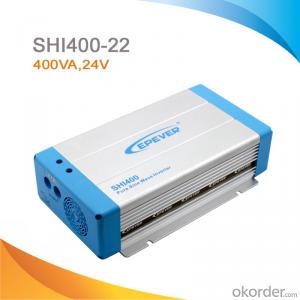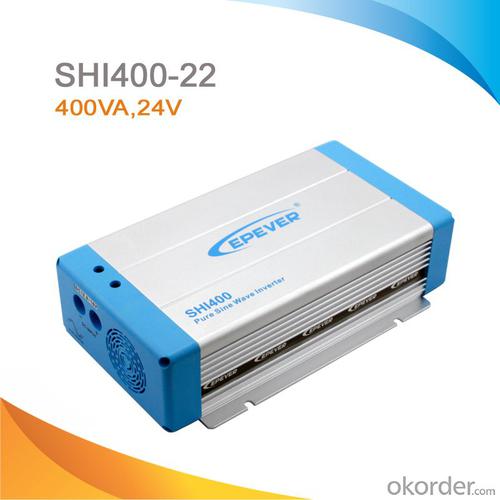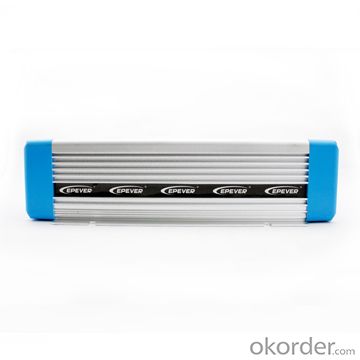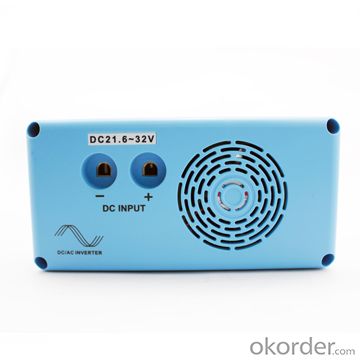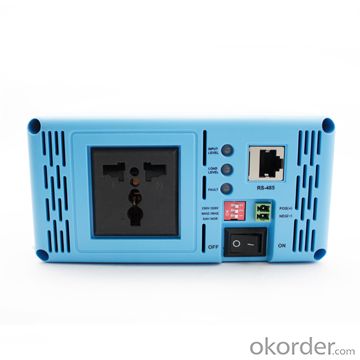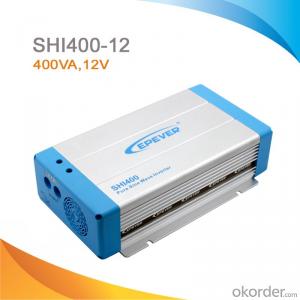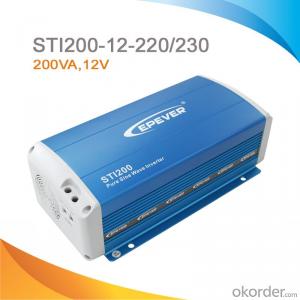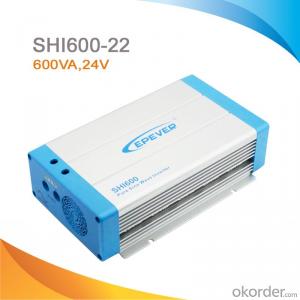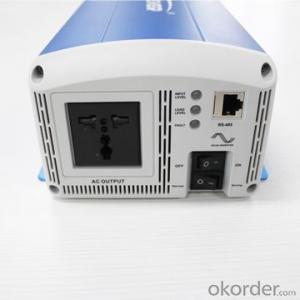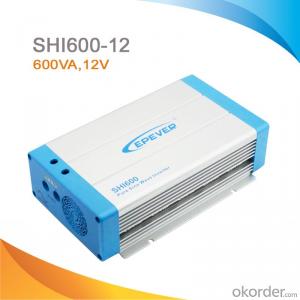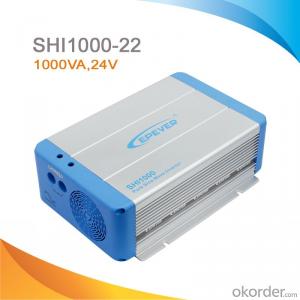35KW Solar Inverter - Off-grid Pure Sine Wave Solar Inverter/Power Inverter 400W, DC 24V to AC 220V/230V SHI400-22
- Loading Port:
- China Main Port
- Payment Terms:
- TT or LC
- Min Order Qty:
- -
- Supply Capability:
- -
OKorder Service Pledge
OKorder Financial Service
You Might Also Like
SHI series is a pure sine wave inverter which can convert 12/24/48Vdc to 220/230Vac 50/60Hz based on full digital and intelligent design. It features high reliability, high efficiency, concise outline, small volume, easy installation and operation. The inverter can be applied in many fields, such as household appliances, electric tools and industrial devices etc, especially for solar photovoltaic power system.
True sine wave inverters produce power that is either identical or sometimes slightly better to power from the public utility power grid system. The power wave when viewed through an oscilloscope is a smooth sine wave.
Features:
·Input & output fully isolation
·Adoption of advanced SPWM technology, pure sine wave output
·Dynamic current loop control technology to ensure inverter reliable operation
·Wide DC input voltage range
·The output voltage and frequency can be switched
·Low output harmonic distortion(THD≤3%)
·LED indicators for input voltage range, load power range, normal output & failure state
·Optional energy saving mode
·Wide working temperature range (industrial level)
·Continuous operation at full power
Protections:
·Output short circuit protection
·Overload protection
·Input low voltage protection
·Input over voltage protection
·Overheating protection
·Inverter abnormal protection
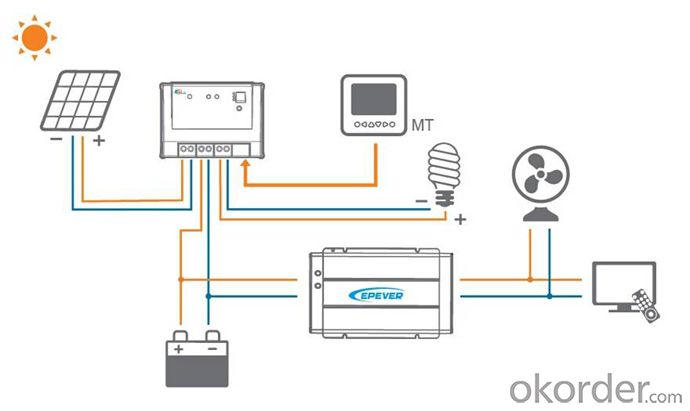
Specification:
Types | SHI400-12 | SHI400-22 | SHI600-12 | SHI600-22 | SHI1000-22 | SHI1000-42 |
Nominal Battery Voltage | 12V | 24V | 12V | 24V | 24V | 48V |
Input Voltage Range | 10.8~16Vdc | 21.6~32Vdc | 10.8~16Vdc | 21.6~32Vdc | 21.6~32Vdc | 43.2~64Vdc |
No Load Current | ≤0.8A | ≤0.45A | ≤0.7A | ≤0.45A | ≤0.45A | ≤0.35A |
Output Wave | Pure Sine Wave | |||||
Output Voltage | 220Vac±3% / 230Vac±10% | |||||
Continuous Power | 400W | 600W | 1000W | |||
Power 10 sec | 600W | 900W | 1500W | |||
Power 1.5 sec | 800W | 1200W | 2000W | |||
Surge Power | 900W | 1350W | 2250W | |||
Frequency | 50/60Hz±0.2% | |||||
Distortion THD | ≤ 3% (resistive load) | |||||
Efficiency at Rated Power | ≥91% | ≥92% | ≥91% | ≥92% | ≥93% | ≥93.5% |
Max. Efficiency | ≥92% | ≥93% | ≥93% | ≥94% | ≥94% | ≥94% |
Terminal | 16mm2 | 25mm2 | 25mm2 | |||
Dimensions | 280×166×74.3mm | 295×186×82mm | 295×208×98mm | |||
Installation | 150×158mm | 150×178mm | 150×200mm | |||
Hole Size | Φ5mm | Φ6mm | Φ6mm | |||
Net Weight | 1.8kg | 2.3kg | 3.3kg | |||
Working Temperature | -20℃~ +50℃ | |||||
Storage Temperature | -35℃~ +70℃ | |||||
Humidity | < 95% (N.C.) | |||||
Altitude | < 5000m(Derating to operate according to IEC62040 at a height exceeding 1000m) | |||||
Insulation Resistance | Between DC input terminals and metal case: ≥550MΩ; Between AC output terminals and metal case: ≥550MΩ. | |||||
Dielectric Strength | Between DC input terminals and metal case: Test voltage AC1500V, 1 minute Between AC output terminals and metal case: Test voltage AC1500V, 1 minute | |||||
- Q: What is the role of Maximum Power Point Tracking (MPPT) in a solar inverter?
- The role of Maximum Power Point Tracking (MPPT) in a solar inverter is to optimize the power output from the solar panels by constantly adjusting the voltage and current to ensure that the solar panels are operating at their maximum power point. This allows the solar inverter to efficiently convert the DC power generated by the solar panels into AC power for use in homes or businesses. By tracking and adjusting the maximum power point, MPPT technology maximizes the overall energy production and improves the overall efficiency of the solar inverter system.
- Q: What is the typical installation process for a solar inverter?
- The typical installation process for a solar inverter involves several steps. First, a suitable location for the inverter is identified, usually near the solar panels. The inverter is then mounted securely on a wall or other structure. Next, the DC wiring from the solar panels is connected to the input terminals of the inverter, ensuring proper polarity. The AC output terminals of the inverter are then connected to the electrical panel of the building, often through a dedicated circuit breaker. Finally, the inverter is connected to the monitoring system to track its performance and ensure optimal energy production. It is important to follow the manufacturer's instructions and consult a professional electrician to ensure a safe and efficient installation.
- Q: Are there any electromagnetic interference concerns associated with solar inverters?
- Yes, there are electromagnetic interference (EMI) concerns associated with solar inverters. Solar inverters convert the direct current (DC) generated by solar panels into alternating current (AC) that can be used to power homes and businesses. During this conversion process, high frequency switching occurs, which can generate EMI. EMI refers to the disturbance caused by electromagnetic radiation from electronic devices, which can interfere with the proper functioning of other electronic devices in close proximity. In the case of solar inverters, the EMI generated can potentially affect nearby electronic equipment, such as radios, televisions, or communication systems. To mitigate these concerns, solar inverter manufacturers often comply with relevant EMI standards and regulations. These may include limits on the amount of electromagnetic radiation emitted by the inverters and the use of shielding materials to reduce EMI. Additionally, some inverters incorporate filters or other EMI suppression techniques to minimize the interference created. It is important for solar installers and system designers to consider EMI concerns when selecting and positioning solar inverters. Proper installation and grounding techniques can help reduce EMI issues. Additionally, local regulations and guidelines should be followed to ensure compliance with EMI standards and to minimize potential interference with other electronic devices. Overall, while there are EMI concerns associated with solar inverters, proper design, installation, and adherence to relevant standards can effectively mitigate these concerns and ensure the smooth operation of both the solar system and other electronic equipment in the vicinity.
- Q: Can a solar inverter be used with different grid voltages?
- No, a solar inverter is designed to work with specific grid voltages and is not compatible with different grid voltages.
- Q: How does a solar inverter handle variations in solar irradiation?
- A solar inverter handles variations in solar irradiation by continuously monitoring the amount of sunlight received and adjusting the conversion of direct current (DC) power generated by the solar panels into alternating current (AC) power accordingly. It does this by employing maximum power point tracking (MPPT) algorithms that optimize the power output from the panels, ensuring maximum efficiency regardless of the fluctuations in solar irradiation.
- Q: Can a solar inverter be used in a solar-powered irrigation system?
- Yes, a solar inverter can be used in a solar-powered irrigation system. A solar inverter is responsible for converting the direct current (DC) produced by solar panels into alternating current (AC), which is necessary for powering electrical devices such as pumps and motors in an irrigation system. By connecting the solar panels to a solar inverter, the energy generated by the sun can be efficiently utilized to operate the irrigation system, making it a sustainable and cost-effective solution for agricultural purposes.
- Q: What is the role of reactive power injection in a solar inverter?
- The role of reactive power injection in a solar inverter is to improve the power factor of the system. It helps in balancing the reactive power generated by the solar panels, which is essential for efficient power transmission and distribution. By injecting reactive power, the solar inverter ensures that the system operates at a near unity power factor, minimizing losses and enhancing the overall performance of the solar power plant.
- Q: How does a solar inverter handle sudden changes in solar irradiance?
- A solar inverter handles sudden changes in solar irradiance by continuously monitoring the incoming solar energy and adjusting its output accordingly. When there is a sudden increase in solar irradiance, the inverter quickly ramps up its power output to match the new level of energy being generated. Similarly, if there is a sudden decrease in solar irradiance, the inverter rapidly decreases its output to prevent overloading. This dynamic response ensures optimal power generation and protects the system from potential damage due to irregular fluctuations in solar irradiance.
- Q: Can a solar inverter be used in systems with different module currents?
- Yes, a solar inverter can be used in systems with different module currents. Solar inverters are designed to convert the DC power generated by solar panels (modules) into AC power that can be used by electrical devices. They are typically equipped with Maximum Power Point Tracking (MPPT) technology, which allows them to optimize the power output from the solar panels regardless of their current ratings. This means that solar inverters can efficiently handle systems with different module currents and ensure the maximum power generation from the solar panels.
- Q: What is the role of a solar inverter in anti-islanding protection?
- The role of a solar inverter in anti-islanding protection is to detect when there is a loss of utility power and to disconnect the solar system from the grid. This is important to prevent the system from continuing to generate power during a power outage, which could pose a safety risk to utility workers who may be working on the grid. The solar inverter ensures that the solar system is synchronized with the grid and only operates when there is a stable utility power supply, thus providing a reliable and safe connection to the grid.
Send your message to us
35KW Solar Inverter - Off-grid Pure Sine Wave Solar Inverter/Power Inverter 400W, DC 24V to AC 220V/230V SHI400-22
- Loading Port:
- China Main Port
- Payment Terms:
- TT or LC
- Min Order Qty:
- -
- Supply Capability:
- -
OKorder Service Pledge
OKorder Financial Service
Similar products
Hot products
Hot Searches
Related keywords
